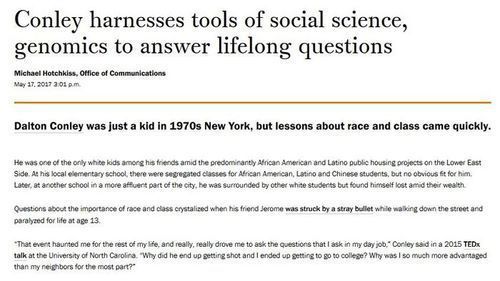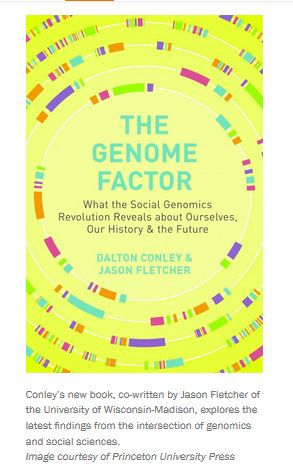
Dalton Conley’s THE GENOME FACTOR — Empirically Testing THE BELL CURVE
By Steve Sailer
05/12/2018
Dalton Conley is a professor of sociology, now at Princeton, who decided a number of years ago to take seriously the influence of genetics on society, so he also recently picked up a second Ph.D., this one in biology. He has a recent book out, The e Factor, that is a tough read but has some pretty mindwarping studies. From the Princeton PR department:
Conley harnesses tools of social science, genomics to answer lifelong questions
Michael Hotchkiss, Office of Communications
May 17, 2017 3:01 p.m.Dalton Conley, Princeton’s Henry Putnam University Professor in Sociology, examines the complicated ways genes and environment interact to affect who moves up — and down — the socioeconomic ladder.
Dalton Conley was just a kid in 1970s New York, but lessons about race and class came quickly.
He was one of the only white kids among his friends amid the predominantly African American and Latino public housing projects on the Lower East Side. At his local elementary school, there were segregated classes for African American, Latino and Chinese students, but no obvious fit for him. Later, at another school in a more affluent part of the city, he was surrounded by other white students but found himself lost amid their wealth.
Questions about the importance of race and class crystalized when his friend Jerome was struck by a stray bullet while walking down the street and paralyzed for life at age 13.
“That event haunted me for the rest of my life, and really, really drove me to ask the questions that I ask in my day job,” Conley said in a 2015 TEDx talk at the University of North Carolina. “Why did he end up getting shot and I ended up getting to go to college? Why was I so much more advantaged than my neighbors for the most part?”
The search for answers has driven Conley, Princeton’s Henry Putnam University Professor in Sociology, to combine the power of new genetic tools with traditional social science in research that goes beyond the nature versus nurture debate to focus on how genes and environment interact to shape life outcomes.“In my mind, it’s all very much trying to get at the same big question of how social status and health get transmitted from parents to children,” Conley said. “I’m like a dog trying to get at the marrow of a bone, focusing on different factors and methodological questions to find the answer.”
The Genome Factor: What the Social Genomics Revolution Reveals about Ourselves, Our History & the Future by Dalton Conley & Jason Fletcher
Conley’s new book, co-written by Jason Fletcher of the University of Wisconsin-Madison, explores the latest findings from the intersection of genomics and social sciences. …In “The Starting Gate: Birth Weight and Life Chances” (University of California Press, 2003), Conley and co-authors Kate Strully and Neil Bennett examined the example of birth weight — which is often accompanied by social risk factors such as minority racial status, low education, young maternal age and low income — to highlight the challenges of sorting through biological and social factors that affect life outcomes.
The research in those books and other work Conley conducted to that point used the traditional tools of social science, such as surveys and natural experiments. But he couldn’t be sure that the factors he identified as related to outcomes were the keys or if they were masking some other, unknown influencer. One of the most likely hidden variables: genetics.
So Conley went back to school, earning a second Ph.D., in genomics, from New York University in 2014. Now, taking advantages of recent advances in human genotyping, he uses polygenic scores that distill information from across the genome to measure an individual’s genetic predisposition for a certain characteristic, such as above-average height or autism. The scores vary in their predictive ability but offer important evidence to add to work on social influences for the same factors.
For example, Conley and colleagues used polygenic scores to find that genes began to play a greater role in the height and body mass index of Americans over the 20th century, while their significance decreased in educational outcomes and occurrence of heart disease. The findings were published last year in the journal Scientific Reports.
“We’re all responding differently to environmental influences and shocks happening to us all the time in society, but we haven’t had any idea who was going to respond how,” Conley said. “Now we’re uncovering the genetic tools needed to answer those questions.”
Conley’s work on gene-environment interaction represents an important advance, said Sara McLanahan, the William S. Tod Professor of Sociology and Public Affairs and director of the Center for Research on Child Wellbeing.
“This work on gene-environment interaction is exciting because it goes beyond the old debate of nature versus nurture, and it brings in potentially a much more powerful role of the social environment,” said McLanahan, whose research has examined policies aimed at improving the education and health of children. “By understanding how a person’s genes interact with their environment, we’re really going to be able to tailor social interventions much more effectively.”
For example, an intervention might be a change in the way children are taught to read. On average, the change might have only a small impact on children’s performance. But by including information on children’s genetics, researchers might learn that children with certain genotypes benefit greatly from the intervention while others don’t benefit at all.
“The average effect we’ve been measuring may be a huge underestimate of the potential power of an intervention for the kids who are genetically suited for it,” McLanahan said.
He’s also using a polygenic score for predicting IQ to begin to empirically test a number of Richard J. Herrnstein’s predictions for the historically course of American society that he first made in his semi-legendary 1971 Atlantic article “I.Q.,” such as that people would assortatively mate more on IQ over time. (This article provided much of the theoretical impetus for The Bell Curve 23 years later.) Conley has access to a bunch of genetic studies with data on Americans of different ages, so he can calculate whether old married couples are less similar on IQ (as predicted by polygenic scores for IQ) than younger married couples, as Herrnstein guessed.
One of the weirder promises of genetic research for the human sciences is that you may in the future be able to reconstruct the answer to questions that people forgot to ask in the past.
For example, if you have DNA from old people, or even, as Svante Paabo and David Reich showed, from dead people, you can, increasingly, estimate what their genes made their phenotypes like.
Conley’s initial findings do not support Herrnstein’s famous assumptions:
We deploy those data from the Health and Retirement Study in order to test the core series of propositions offered by Herrnstein and Murray in 1994. First, we ask whether the effect of genotype is increasing in predictive power across birth cohorts in the middle twentieth century. Second, we ask whether assortative mating on relevant genotypes is increasing across the same time period. Finally, we ask whether educational genotypes are increasingly predictive of fertility (number ever born [NEB]) in tandem with the rising (negative) association of educational outcomes and NEB. The answers to these questions are mostly no; while molecular genetic markers can predict educational attainment, we find little evidence for the proposition that we are becoming increasingly genetically stratified.
A big question, of course, is whether it’s too early in the study of the genetics of IQ for what Conley is trying to do (the polygenic scores Conley are using only account for a tenth or so of IQ variation).
But what he’s attempting is pretty spectacular and deserves discussion.

